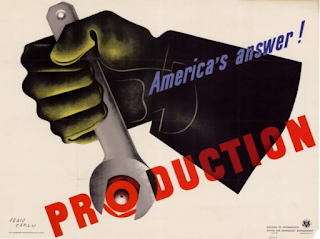The “conservatives”
claim that taxing corporations less will stimulate the economy, result in new
capital formation, and create jobs. The “liberals”
claim that taxing corporations less will mean taxing people more, depress the
economy, result in new capital formation, and destroy jobs.
 |
| 94% tax rate, 13 million out of the work force, and 14% growth. |
It’s good to see the “conservatives”
and the “liberals” agree on one thing, at least: the belief that taxing
corporations less will result in new capital formation. It’s bad to see that the one thing they agree
on is as wrong-headed as the things on which they disagree.
How’s that? Doesn’t cutting corporate taxes mean that it
is more profitable for a corporation to expand by purchasing new capital and
creating jobs?
Well . . . no. Here’s a fun historical fact: did you know
that during World War II the top marginal tax rate was 94% in order to
discourage war profiteering and raise as much money as possible for the war
effort? And how much were corporate
profits hurt, or the rate of economic growth slowed?
Not at all. The average
rate of growth of the U.S. economy during WWII was a little short of 14%. In 1942, it got close to 40%, dropped to less
than 1% in 1943 when short term capacity was reached, then shot up again in
1944. And profits? The stock market (and dividend rates) kept
pace with the rate of growth. The
problem was not insufficient growth, it was too much money from the growth
floating around that people couldn’t spend because the government was buying
virtually everything for the war effort.
They had to institute rationing to keep prices down.
 |
| And, in case you didn't hear, we won the war. Now let's win the peace. |
And the lesson to be
learned? That economic growth is not
driven by the demand for new capital, or the rate of taxation, but by consumer
demand. The U.S. economy had a customer
for everything that could be
produced, and then some. Thus, even with
a top tax rate of 94%, corporations made money hand over fist. It wasn’t the tax rate that determined the
rate of economic growth, but the fact that there was a customer with money,
ready, willing, and able to buy whatever was produced.
The real question,
then, is how to get money into the hands of customers who want to buy (“demand”)
what producers want to supply . . . which is precisely what no one is looking
at, except those who have investigated the Just Third Way.
When there’s a war on
(some solution), that’s not a problem, assuming the politicians who probably got
you into the war in the first place by doing something stupid don’t do
something even more stupid and try to finance the war by creating money backed
by government debt. Under Say’s Law of
Markets — assuming it is allowed to operate — production equals income,
therefore supply generates its own demand, and demand its own supply (that’s an
oversimplification, but we can get into the complexities another time).
 |
| Say called it: it's supply and demand, not tax rates |
Thus — again, given
Say’s Law — financing even a war is very simple in theory. Since “money” is “all things transferred in
commerce,” if something is produced for which a demand exists, there is
automatically enough money to clear all goods at market prices without
inflation or deflation. It’s just a
question of who has it. When a
government finances its operations by taxation, the amount of money in the
system stays the same. It’s just
different people spending it for the same amount of production.
A problem crops up
when the government “creates” money to finance operations. The government, as a non-producer, actually
doesn’t have the power to do so, not legitimately, anyway. By creating money backed by its own debt,
government increases demand in the system artificially, forcing prices to rise
due to the fact that it is not creating money by producing or promising to
produce, but by a promise to take from producers in the future. This throws Say’s Law out of balance.
So — unless the
government is effectively stealing from people by decreasing the value of their
money through inflation — the rate of taxation does not have any effect on
economic growth. Whether people spend
it, or the government spends it, the same amount of money is spent. All a change in the tax rate does is change
who is spending it, not how much is spent, and thus has no effect on the rate
of new capital formation or job creation.
It’s simple math.
So, what will
stimulate the rate of economic growth if lowering taxes will not?
Putting money into
people’s hands who will produce and spend money on consumption, not those who
will simply use money to produce more without consuming, or consume without
producing.
And we’ll take a look
at how to do that, tomorrow.
#30#
